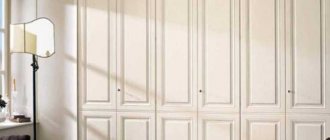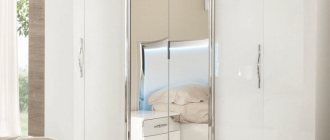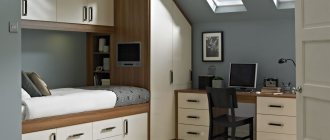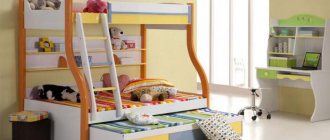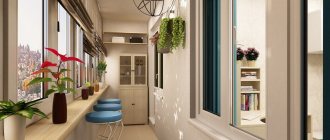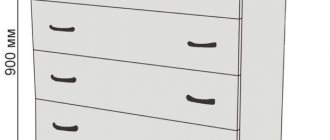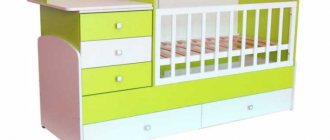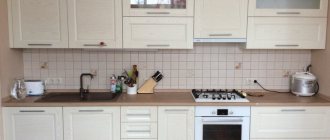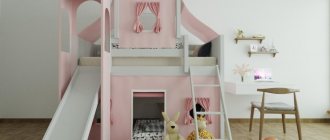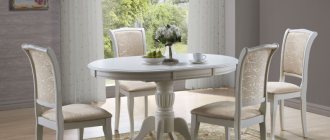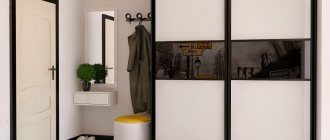32766
Among cabinet furniture, we should separately highlight the radius corner wardrobe, which is not only functional, but also looks very impressive in the interior. For the designers of the radius coupe it was simply a revelation. And not only because it can be placed in any corner. A rounded cabinet with mirrors, photo printing and other decors literally transforms the room. Unlike swing furniture doors, corner compartment doors look elegant and unusual. For the manufacture of rounded doors, modern composite materials are used to create modern interiors. In the photo you can see these futuristic models.
Variety of radius designs
The main feature of radius sliding wardrobes is the absence of sharp corners. All outlines and lines are smooth, and the shape is curved or convex. The advantages of the designs include:
- high capacity, ergonomics;
- versatility of use - models are suitable for living rooms, children's rooms, bedrooms, hallways, as well as office spaces;
- a variety of options for internal filling and shapes;
- Possibility of installation in a corner or against a wall.
Disadvantages include high cost and complexity of installation. It is better to entrust the assembly of the radius cabinet to specialists. Structures are classified according to installation method. Each model has its own characteristics:
- Corpus. Equipped with back and side walls, lid, bottom, shelves. Installed in a pre-prepared place. Advantages - a wide range of models, furniture can be rearranged and transported. Disadvantages: dust accumulates behind the cabinet and on the top panel, high cost.
- Built-in. The products do not have side walls, lids, or bottoms. Mounted in corners, free niches. Advantages: lower cost compared to cabinet structures, ability to use all usable space, high capacity, masking of surface defects. Disadvantage: the models cannot be transported or rearranged to another location.
The radius cabinet can have a straight or angular shape. Linear structures are located along one of the walls. The advantages include versatility of use, convenience, and functionality. The main disadvantage is that they take up a lot of space.
The corner cabinet is equipped with symmetrical or asymmetrical fronts. Ideal for installation in rooms with limited space: bedroom, bathroom, loggia, hallway. The advantages of the models are versatility, space saving, aesthetic appeal. Disadvantages include installation difficulties and low strength of the sliding structure.
The radius cabinet occupies a minimum of usable space due to its small size or the absence of side walls, which are typical for standard rectangular models.
Hull
Built-in
Straight
Corner asymmetric
Corner symmetrical
Advantages and disadvantages
Radius furniture has a curved facade, often with decorative elements. It can be installed in difficult areas with external corners, in niches, with limited space.
Advantages of a radius sliding wardrobe:
- Exclusive design. The curved shape of the facade can combine curved and concave lines. Such a facade will have a wavy outline.
- A large radius in the form of a circular sector helps soften the corners in the room.
- Ergonomics and compactness - concave facades can be used in narrow areas of the hallway, and convex ones in wide areas.
- Suitable for storing items with non-standard dimensions.
- They are built-in and modular.
- If necessary, sliding doors are complemented by swing doors.
- Ease of use. Even large items can be placed inside.;
- Silent opening of the doors.
- They emphasize the radial design of multi-level ceilings.
The cabinet facade follows the lines on the ceiling.
Design disadvantages should also be taken into account:
- A radius cabinet can accommodate fewer things than a regular cabinet due to the internal filling.
- Such furniture is about half more expensive, as the consumption of materials, the cost of their processing and quality requirements increase.
- You cannot install a mirror on the door because the reflection will be distorted.
- Replacing radius guides is difficult because it is difficult to find a part with the desired radius.
In the limited space of the hallway, radius sliding wardrobes fulfill their functions 100%. They allow you to make good use of any amount of free space, while complementing the interior with an interesting design.
Basic radial schemes
The range of radius cabinets is presented in several varieties, which differ in shape. When choosing, the parameters of the installation location and individual preferences are taken into account. Manufacturers offer the following options:
- Curved - a model in the form of a hemisphere with narrow side walls. Typically used to design built-in wardrobes, which are mounted in specially designated niches. An ideal scheme for areas where it is impossible to install standard structures.
- Concave - the door leaf is slightly recessed inward relative to the side walls. It is characterized by less capacity compared to the curved shape, but is distinguished by smooth lines and the ability to visually increase space.
- Combined or concave-convex - a radius cabinet combines the features of two varieties and has a wave-like shape. The models will become an original interior decoration.
- Asymmetrical - compact in size, high capacity. When decorating doors with reflective sheets, it helps to visually expand the space.
- Round - looks unusual, harmonizes with modern interior styles.
- Only with a side radius section - in appearance it resembles standard rectangular cabinets, in which one side is rounded. The products save space and look unusual.
A variety of models of two-door wardrobes, examples of placement.
The choice of the optimal layout depends on the characteristics of the room. Curved radius models are installed in small closets and hallways, which are converted into a dressing room. Cabinets with concave doors are often used to decorate a classic interior; asymmetrical ones are relevant for rectangular rooms. Round products are installed in spacious halls, living rooms, and serve for zoning space.
Curved
Concave
Combined
Asymmetric
Round
With side radius section
Varieties
Radial cabinets differ in the shape of the corner in which they are mounted. Products are also classified according to the type of external surface that faces the room. Basic options will suit most interiors. But owners of non-standard premises will have to order furniture individually.
Types of cabinets according to the shape of the corners:
- 90 degrees is the simplest design. It is mounted in a regular right angle, that is, it will suit almost any room. The closet is spacious and takes up little space. Due to various design solutions it can visually enlarge or reduce the room. The design is usually symmetrical.
- Offset - asymmetrical model. The part located along one wall is larger than the second. Suitable for narrow long rooms. Uses corners where another structure would not fit - for example, the corner next to the front door, where it is impossible to place a cabinet with hinged doors. Externally, it conceals the difference between the lengths of the walls and balances the room.
- Beveled - such a corner wardrobe expands or narrows from the center to the edge. The design can be narrow in the corner (filled with decorative elements) and wide at the edges (more space for storing small items: clothes, dishes, shoes). The opposite option - the closet narrows towards the edges, making its contents more accessible, but at the same time it expands towards the center, creating volume for storing large items (household appliances, boxes of out-of-season shoes and clothes).
- An unfolded cabinet is a model with a relatively small door. It’s convenient to distribute things inside - put away those that are not needed every day against the wall, and put closer those that are needed often. Suitable for rooms not encumbered with furniture, as a means of storing everything at once.
Criteria for choosing white corner cabinets: styles, materials, shades, shapes
90 degrees
Displaced
Beveled
Selecting a cabinet based on design features is the first stage. The next thing to think about is the appearance of the furniture. Based on the shape of the surface, the following types of cabinets can be distinguished:
- Convex. The radius of curvature faces outward. Suitable for large rooms where such a structure can be freely placed. It takes up a lot of space in a small room, but it will look organic in a large one.
- Concave. The cabinet doors are curved inward. Suitable for small rooms - firstly, it frees up space, and secondly, mirrors will help visually expand the space. It is also useful in large rooms if it is consistent with the rest of the interior.
- Wavy. This cabinet combines concave and convex parts. Technically, these models are the most difficult to assemble (the façade elements must be positioned so that the doors easily slide across the space allocated for them). Furniture requires a lot of space along the walls. Suitable for rooms of different sizes with a stylish interior.
There are also separate semicircular radius wardrobes, corner and ordinary. They occupy not only a corner, but also part of the wall; their shape resembles an even semicircle. These designs look good in high-tech rooms, but require a lot of space.
The ideal option for a small room is a cabinet with a concave surface, located at 90 degrees, or offset if the room is narrow.
Convex
Concave
wavy
Semicircular
Size options
Cabinets with radius doors are produced in different sizes, which allows you to choose the right model for spacious and small rooms. The following length options are common:
- Small - 800–1200 mm. Suitable for installation in small hallways, children's rooms, and office spaces.
- Medium - 1300–1800 mm. Optimal for small and spacious apartments.
- Large - 2000–3000 mm. Ideal for large rooms and country houses.
The height of radius cabinets varies. 2000 mm models are suitable for rooms with low ceilings. In most apartments, regardless of square footage, you can use structures with parameters up to 2400 mm.
The minimum depth of cabinets is 35 cm, the maximum is 1 m. The parameters are selected based on the width of the room in which the furniture is installed. The easiest way to calculate sizes is to use special computer programs. With their help, you can set the desired dimensions of the structure, select the number of doors, radial diagram, and type of material. The result will be a complete product design.
Small
Average
Big
Radius cabinet designs
If we talk about the design, the radius cabinet can be built-in or cabinet-mounted. Each type has its own strengths and weaknesses.
Case models
The case version consists of side walls, bottom, lid and back panel. It can be rearranged if necessary. However, it has a higher cost and also reduced internal volume compared to an integrated model of the same size.
Several types of materials are used in the production of the case.
- Natural wood is environmentally safe, highly durable, and has a long service life. However, the high cost of such products forces the average buyer to choose models made from more affordable materials.
- MDF takes second place. Products made from it are durable and will last a long time.
- Chipboard is the cheapest option. This is where its advantages end. It is much inferior to previous types in quality.
- For the back wall, fiberboard and plywood are often used, but the use of chipboard will increase the strength, rigidity of the structure and increase the attractiveness of the product.
If we talk about the thickness of the laminated chipboard used for the sidewalls, it can be 16, 18, 25 mm. The higher the value, the more reliable the furniture will be. The structure of the material consists of 3 layers. It is denser at the edges, which provides protection from mechanical stress. The middle, on the contrary, is loose. This allows you to securely hold the fasteners.
<
>
There are several ways to attach the back panel.
- The simplest one is made with an overlap. It is characterized by low attractiveness and poor reliability. The backdrop is fixed with self-tapping screws, nails or furniture clips. Self-tapping screws are the best option, although the work will take more time.
- The groove system will provide greater strength. They can be located on 2, 3 or 4 sides.
Sometimes the back panel consists of several parts. They are connected to each other with a plastic profile or reinforced tape. But it is better to opt for a product with a solid surface.
Built-in wardrobes
Built-in furniture is different in that some of the functional parts replace the walls, floor and ceiling of the room. Its dimensions are determined by the individual characteristics of the room. Changing the location of the built-in wardrobe will be difficult, but such furniture will allow you to make the best use of the allocated space. Its installation will require internal filling and a façade. However, in order for the product to function without surprises, it is necessary to prepare the selected area: check the strength, level the surfaces and carry out finishing work.
Radius cabinet facade - types and features
Radius facades have limitations associated with the possible bending limit of the selected material. Exceeding extreme values will lead to rapid destruction of structural elements. When making calculations, the location of the furniture, the area of the room and the design solution are taken into account. External radii are 300, 700 and 1000 mm, and internal radii are represented by one value - 300 mm.
The number of doors is calculated based on the length of the arc. The following must be taken into account:
- the width of one door should not be less than 500 mm, otherwise the doors will constantly slide off the rails;
- the number of doors must match the number of compartments, otherwise “dead” zones will form;
- all parts of the curved facade have the same width, the optimal interval is from 60 to 90 cm.
Several types of materials are used to make facades.
- MDF is used most often. A slab of vacuum-pressed wood chips is given a certain bend.
- Curved tempered glass is framed by an aluminum profile.
- Plastic is available in a wide range of colors, is durable and lightweight.
- Solid wood is used quite rarely due to its high cost.
Decoration is carried out using different techniques:
- photo printing;
- sandblasting;
- fusing;
- painting with special paints;
- stained glass inserts;
- combination of different materials.
Features of choosing a sliding system
The non-standard shape of cabinet and built-in radius wardrobes requires the correct choice of sliding systems. The reliability and ease of use of the design depend on them. The following options are in demand:
- Top-hung - most often used in built-in wardrobes, fixed to the ceiling. Before installation, the top surface will need to be reinforced so that it can support heavy weight.
- Based on the bottom rails - a universal sliding system that can be installed before or after installing the door leaf. The main load falls on the lower surfaces, so reinforcement of the ceilings is not required.
Great importance is given to fittings for radius sliding wardrobes. These are side profiles that act as handles, frames, rollers, door filling, stopper, assembly and adjustment screws. When choosing, you need to pay attention to the quality of workmanship, reliability of products, and manufacturer.
The best brands of sliding systems are considered to be Blum (Austria), Hettich (Germany). The range includes lifting mechanisms, hidden guides, furniture hinges and other products. The products of these companies are of high quality and are popular all over the world.
Top-hung sliding system
Support on the lower rails
Hettich sliding system
Furniture fittings Blum
Selection of all materials for production
For a built-in bent cabinet model, you should prepare tools and materials in advance. The profile and components for doors are selected especially carefully. Be sure to prepare a drawing with all dimensions in advance. If you have any difficulties during the design, you can use the services of an online designer.
Tools you will need:
- square;
- screwdriver;
- pencil;
- level;
- drill;
- dowels;
- hammer;
- roulette.
Before starting work, make sure you have all the necessary tools.
Materials needed:
- furniture panel;
- false panels;
- accessories;
- doors;
- profiles;
- shelves and drawers.
To make a cabinet you will need furniture board and other materials.
Radius profiles
For the manufacture of furniture, 2 types of profiles can be used: steel and aluminum. For radial cabinets, aluminum is preferable. The normal thickness is considered to be 1.2 mm, but profiles with thicker walls are more often used. Problems can arise with thin sweat: sheets of facades can “jump” out of them.
Profiles can be steel or aluminum.
A big mistake is to use profiles that are used for straight structures. With force, they can be bent, but the integrity of the oxide film on them is damaged, and anodizing has to be done again. At home, this is a very troublesome task. It is better to immediately select radius profiles for curved sliding wardrobes.
It is recommended to use bent profiles designed for radius cabinets.
Other materials
To make unusual and beautiful doors for a curved sliding wardrobe, you should separately prepare the following materials:
- vertical side profiles (asymmetrical ones divide the sash into outer and outer sides, symmetrical ones look the same);
- upper frame for installing rollers and doors in the opening from above;
- asymmetrical upper rollers;
- lower frame - wheels will be attached to it, ensuring the sliding of the doors;
- sealing tape – protects the door from impacts and prevents dust from entering;
- screws – assembly and adjustment (facilitate the sliding process);
- stopper – fixes the door in the selected position.
You need to decide on the dimensions of the curved cabinet. The minimum depth is 60 cm. Shelves should not be wider than 65 cm, otherwise they will sag under the weight of things. For doors, leaf widths less than 50 cm can cause them to jump out of the guides. There should be as many doors as there are compartments inside.
Materials and internal filling
Cabinets should not only be aesthetically attractive, but also reliable and durable. The main characteristics of products depend on the material of manufacture. The following varieties are considered the most popular:
- Chipboard. The boards are made from a mixture of large wood chips and resin. Thanks to the variety of textures and colors, you can choose a radius cabinet for any interior. Advantages - affordable cost, versatility of use, light weight, resistance to mold, rot, attractive appearance. Disadvantages - content of toxic impurities, deformation when exposed to moisture, service life - up to 10 years.
- MDF. The material is made from sawdust and has greater strength and reliability compared to chipboard. The slabs have a perfectly flat surface and are suitable for creating concave or convex elements. Advantages: environmental safety, moisture resistance, long service life (from 10 to 30 years), ease of maintenance. Disadvantages - low resistance to high temperatures and mechanical stress.
- Tree. Traditional material for making sliding wardrobes. Budget furniture is made from birch and pine, expensive products are made from oak, cherry, and ash. Advantages - environmental safety, presentable appearance, durability, reliability, structures are subject to repair and restoration if there is serious damage. Disadvantages: high maintenance requirements, high cost, design does not always fit into modern interiors.
Features of sandblasting patterns on the wardrobe mirror, photo of decor
When choosing a wardrobe, the internal contents must be taken into account. Boxes, shelves, shoe nets, baskets, stands, rods serve for convenient placement and compact storage of things. Ease of use of the furniture is ensured by additional equipment - pantographs. Thanks to the presence of a special handle, the bar with clothes can be easily lowered and extended to the optimal height.
Chipboard
MDF
Tree
Internal filling
Rational use of available space
Shelves, drawers and rods are needed for convenient placement and compact storage of things
What material is used in radius structures
Depending on the complexity of the design and the materials used, the price of corner built-in furniture will change.
When choosing an economy class option, it is preferable to use stainless steel guides, handles and door contours. Often, for more economical options, chipboard 8-10 mm thick and plastic are used for doors. Chipboard may vary in color and thickness. The price of the cabinet depends on the chipboard manufacturer. Products from Europe are more expensive, domestic products are cheaper. It is worth taking a closer look at the appearance of the edges in the chipboard. If the edge is overhead, it is secured manually. When making furniture on special machines, the PVC edge is securely attached, has a thickness of up to 3 mm and has a longer service life.
The steel profile gives the structure reliability.
For the luxury class, aluminum profiles are used. This design is more suitable for high ceilings. The door movement will be softer, and the sliding mechanism can be hidden.
Almost any material can be used for the door. Doors made of glass and acrylic look interesting. Photo printing, mirror inserts, and stained glass compositions are widely used in the design of facades.
Additional functionality
A standard radius wardrobe includes small and large storage compartments, rods and grids. No additional devices are provided in the designs. Such models are distinguished by their simplicity, practicality, and affordable cost. Improved options are equipped with functional devices:
- backlighting - for easy searching of things, an LED strip or spotlights are attached to the contours of the shelves;
- open shelves - allow you to place books, souvenirs, useful items;
- niche for a TV - a radius cabinet can be equipped with special sections for installing radio and television equipment;
- a compartment for an ironing board - this addition can be easily folded out and takes up minimal storage space;
- built-in furniture - in a small bedroom you can provide a dressing table hidden in the closet.
You can choose radius cabinet models, complemented by a full-fledged workplace and secretary.
The straight or corner design can be complemented by drawers with dividers for storing small accessories. The sides on the shelves prevent things from falling out, holders for skirts and trousers are equipped with rotating mechanisms, hangers for belts and ties are made in the shape of a fan. The fragrance section with a fan and aromatic balls quickly refreshes things and eliminates strong unpleasant odors.
Backlit
With open shelves
With a niche for a TV
With compartment for ironing board
With built-in furniture
Kinds
The radius design can be presented in several varieties, significantly different from each other in shape. During the selection, it is taken into account what dimensions the space allocated for installation has, as well as what shape is preferable for future users.
The shape of a radius sliding wardrobe can be:
- convex - most often a built-in wardrobe installed in a niche has this shape. It is ideal for areas that are not suitable for installing standard furnishings. Such a radius sliding wardrobe is often chosen for a hallway or a small storage room, converted into a small dressing room;
- concave - such cabinets have doors that are slightly pressed inward. Due to this design, a visual increase in the surrounding space is ensured, and this is especially true with the mirror design of swing doors. The unusual shape ensures smooth corners, so the room becomes deeper and more spacious. A concave cabinet often decorates standard interiors;
- combined - this form for radial cabinets is used quite often. It involves combining the features and appearance of the two above varieties. Therefore, the resulting cabinets look like a wave, which is convex in one place and concave in another. Such designs look great with a glass door in the living room or bedroom;
- round - fit perfectly into the high-tech style, as they resemble an unusual and modern capsule. Such cabinets with a radius section have an unusual feature, since they fit well only into large rooms. Therefore, if you have a small living room, then it is better to choose another model;
- corner - such a cabinet, which has a mirrored facade, is considered an ideal choice for a room with small dimensions. It can be made in white or other colors. It has a triangular shape at the base, but at the same time retains a radius design. Furniture with such a radius is easy to install and can also be equipped with straight sections and shelves. The cost of corner models is considered affordable, and they are also universal, so they can be installed in various rooms, regardless of their size.
When choosing any model of a sliding wardrobe, you should carefully study all the components of the door opening mechanism, therefore, take into account the profile dimensions, the material of the guides and the quality of the rollers. Most buyers prefer to use a concave cabinet due to its specific appearance.
Separately, we should highlight cabinet radially made cabinets, which are equipped with rear and side walls. They have different shelves, bottom and lid. No adjustment is required for such furniture, so it can be easily installed in any place chosen in advance by users. Cabinet cabinets are single structures that can be easily rearranged around the living space.
Also, people often prefer to use a built-in design. It is not equipped with side walls, so the walls of the room are usually used as them. The floor acts as the bottom, and the ceiling of the room is used instead of the lid. Due to the specific dimensions of the cabinet itself and the doors, such furniture is usually created to order. The built-in wardrobe is selected depending on the size of the existing niche allocated for installation.
Concave
wavy
Convex
Round
Facade design
The appearance of the furniture depends on the finishing materials, decor, and colors used. In most cases, profiles for radius sliding wardrobes are made of aluminum. The most popular facade finishing options include:
- Lamination - such surfaces are resistant to household chemicals, moisture, and are not afraid of mechanical stress. The popularity of the material is explained by its ease of processing, low maintenance, and affordable cost.
- Mirrors improve lighting and visually increase the space of a room. For safety, the surface is covered with a shockproof film.
- Glass - facades can be glossy or matte, the decor is done using sandblasting and etching.
- Plastic - comes in a variety of colors, it is light weight, but such a facade needs protection from scratches and other mechanical damage.
Purpose of rollers for sliding wardrobes, methods of installing elements
Laminated surface
Mirrors
Glass
Plastic
Various combinations of materials are in fashion. The finishing of a radius wardrobe with a mirror is complemented by wood and plastic, glass is combined with MDF or chipboard. A popular design is in the form of thin metal strips that divide the surface into squares and diamonds, which are filled with stained glass windows and reflective canvases. To decorate original cabinets, non-standard options are used:
- Textured eco-leather - looks respectable and solid, will organically fit into the interior of a library, bedroom or office. The material is in harmony with metal, glass, wood.
- Metal inserts look unusual and are used to divide the door leaf into geometric shapes.
- 3D drawings - urban paintings in black and white and color, inscriptions, slogans, interesting ornaments are popular.
- Solvent, ultraviolet, polymer printing is performed using special inks. Images are bright and long lasting.
- Rattan - a lightweight, beautiful material of plant origin will make an ordinary straight cabinet a real decoration for a room decorated in an ethnic or Japanese style.
The colors of radius models come in a wide variety, but natural wood shades are the most popular. These are exquisite wenge, maple, rich tones of cherry, apple, noble oak, beech. A white cabinet looks luxurious, as well as milk, vanilla, and ivory.
Furniture finishing should match the interior or contrast with it. Cabinets can be painted in light yellow, salmon, blue, soft pink, green shades.
Textured eco-leather inserts
Metal elements
3D drawing
UV printing
With rattan
Colors and decor
Decor options are extremely varied. The most popular is a closet with mirrors, which give you the opportunity to inspect yourself before leaving. And if there are several of them, you can evaluate your appearance from all sides. But it should be remembered that mirrors on round doors will produce distortions, so their main function is to change the appearance of space.
Typical sizes of corner cabinets of different models, non-standard dimensions
You can decorate the facade without a reflective surface. The drawing can be applied in different ways - photo printing, fusing, sandblasting, painting. The choice depends on the interior of the room as a whole. Of course, the design of the closet should be combined with the design of the room. You can depict anything - a landscape, a geometric pattern, a portrait.
Photo printing
Sandblasting
In terms of color and design, the cabinet can be combined with the rest of the furniture, contrast with it, or become a central element of the interior. In any case, you should first draw up a sketch of the entire interior decoration at once. Options for design solutions for various rooms:
- Light pastel colors visually enlarge the space and create a feeling of light. Suitable for any room - this option is considered universal.
- Dark tones smooth out excess light, and color accents look good against their background. This corner cabinet is suitable for a spacious room with large windows. Not suitable for small and dark rooms - this will make them even darker.
- Bright colors create accents. Such a model will definitely attract attention, but it can quickly become familiar and boring to the owner. Suitable for a living room or office, but not for a bedroom.
- Mirrors enhance lighting and visually enlarge the space. Can be combined with facades of any color.
Light furniture is considered a universal option. However, despite the fact that pure white radius wardrobes look luxurious, without proper care the appearance of the facade can quickly deteriorate. Those who are tired of all kinds of “wooden” colors may like soft blue, pistachio, and cream shades.
Corner compartment models organize space where hinged wardrobes cannot cope with this task. Spaciousness, lack of additional space for opening doors, use of corners are their significant advantages. It is not surprising that this design is gaining more and more popularity, despite its high cost - the radius cabinet is really worth the money.
Light pastel colors visually increase the space
Colored inserts look good against dark shades
Bright colors create accents and attract attention. Mirrors are combined with facades of any color and allow you to visually enlarge the space
Light furniture is considered a universal option for any room
Accommodation Tips
Each piece of furniture must occupy a suitable place to ensure maximum functionality and an organic combination with the surrounding environment. Radius cabinets are indispensable in cases where it is necessary to hide irregular corners and save useful space. For optimal placement, it is recommended to take into account the purpose of the rooms:
- Living room or hall. Curved and concave cabinets are suitable. It is better to place furniture in a corner, which often remains free. Models with a niche for a TV and open shelves completely change the interior.
- Children's room. The ideal solution would be a built-in wardrobe. The design has no protruding corners, therefore it is considered the safest for the child. Positive green, blue, light pink, and orange tones are popular.
- Bedroom. Combined, round cabinets are used. Corner options can replace a full-fledged dressing room. Products must fit into the interior of the room; they are often offered in combination with other furniture.
- Hallway. Concave, asymmetrical, wavy models are relevant. Light colors are preferred; spotlights will make the closet feel light and airy.
In a bedroom or living room decorated in a classic style, it is possible to install radius hinged wardrobes. Sliding doors are appropriate only in modern interiors.
The dimensions of the radius cabinet must correspond to the parameters of the premises. For spacious rooms, products are selected in a tone darker than the main background. In conditions of limited space, light designs, decor in the form of mirrors, and photo printing are used. A radius wardrobe with curved fronts will give any room an unusual stylish look. The designs hide design flaws, save usable space, and allow for the most efficient use of space. Thanks to the variety of shapes, materials, and designs, you can choose the best option for any interior.
For the living room
For the bedroom
For children's
For the hallway
Radius wardrobe inside (with photos and dimensions)
Radius sliding wardrobes, which got their name due to their curved facades, give the room a stylish and original look, allow you to make the most efficient use of its space, and hide planning flaws.
They can be installed in any corners and where no other furniture will fit (for example, in a very small hallway or the gap between interior doors that are too close together).
Types of radius sliding wardrobes
Radius cabinets are divided into:
- depending on the configuration of the facades - convex, concave and combined;
- at the installation location - corner and linear (along one wall);
- by design - cabinet-mounted and built-in.
Corner models with convex and concave facades are symmetrical and asymmetrical. They are ideal for installation in small spaces (hallway, bedroom, bathroom, loggia).
Concave wardrobes are less spacious compared to convex ones, but they take up less space and visually expand the space; they do not have a “dead zone” in the corner.
sketch of a concave radius sliding wardrobe with dimensions
A convex wardrobe installed in a large niche can replace a dressing room.
sketch of a convex radius sliding wardrobe with dimensions
In the central part of a linear cabinet with a convex shape, you can arrange a dressing table.
A radial wardrobe with a concave or wavy facade looks especially elegant and eliminates the risk of injury to children and family members with poor vision due to the absence of sharp corners.
An L-shaped wardrobe with a concave corner section allows you to use the space behind the swing door, corrects the proportions of a long room and makes it more comfortable.
sketch of a radius sliding wardrobe with dimensions
The most original and functional option for a studio apartment or spacious room is a corner or linear wardrobe with a combined facade, which combines concave, convex and straight sections (curved surfaces are not suitable for installing mirrors that you need to look into), there are open shelves.
sketch of a radius sliding wardrobe with a “wave” facade and a combined facade
A cabinet wardrobe is a separate piece of furniture that can be freely rearranged anywhere and even transported to another apartment.
The built-in one is installed “once and for all”, therefore it requires a very careful choice of location and careful design calculations.
Filling a radius wardrobe
The main elements of the internal content of radius sliding wardrobes include:
- rods for outerwear and wrinkled clothing;
- shelves on which wrinkle-free items are stored, bed linen, mesh or wicker baskets with various small items, hats, boxes with shoes, bags, sports equipment, suitcases;
- drawers - they are convenient to use for storing underwear, hosiery, gloves, scarves and other accessories.
The most convenient area for use is the middle zone of the closet, so it is recommended to place shelves and rods for everyday clothes there.
It is advisable to use the mezzanine space for storing out-of-season items, and the lower one - depending on the location of the cabinet (in the hallway - for shoes, in the bedroom - for bedding, in the nursery - for toys).
To transform an ordinary wardrobe into the most comfortable storage system, additional accessories are used, the most popular of which are:
- pantographs - devices that lower rods with clothes to the desired height;
- mesh baskets and shelves that provide free visibility and ventilation of things and shoes stored on them;
- Full extension drawers with compartments for small items.
In wardrobes for living rooms and children's rooms, open sections are often made for TV, audio equipment, books, photographs, trinkets, and organization of the workplace.
How to choose the right wardrobe
The most important criteria when choosing a radius sliding wardrobe are:
- purpose, dimensions, layout and design of the premises;
- the type and number of things that will be stored in it - the type and required number of shelves, drawers, clothes rails, shoe baskets, etc. depend on this.
Other important nuances to consider:
- a built-in wardrobe with the same internal volume takes up less space than a cabinet one, and is cheaper due to the absence of a back, one or both side walls, a ceiling plate, or a bottom;
- financial possibilities - if they are not limited, you can choose any materials and accessories, actively use the entire internal space of the cabinet by installing lifting, telescopic and rotating mechanisms, drawers and full extension shelves, trouser holders, tie holders, umbrella stands, and other small components.
If the wardrobe will be used by several family members, it is advisable that each of them have a separate section.
Design - to your taste!
The materials for decorating the facade of a radius sliding wardrobe are so varied that they practically do not limit the flight of the designer’s imagination, and sometimes it takes more than one day to select them.
The most affordable in price are HPL plastics, eco-leather, natural wallpaper, and photo printing. More expensive finishing options include acrylic plastics (frizz, camelit), frescoes, natural veneer, curved glass.
By wisely combining budget materials with expensive ones, you can create real furniture masterpieces even at modest costs.
The easiest way to make a radius wardrobe exclusive is through photo printing, with the help of which you can apply your favorite picture from a magazine, a frame from your favorite movie, a luxurious natural or city landscape to its façade.
The image can occupy the entire surface or only part of it. A pattern that replicates the wall decoration is ideal for creating a fashionable minimalist interior.
The color scheme depends on the purpose of the room and the colors in which its interior is decorated.
Particularly high demands are placed on materials for wardrobes in children's rooms - they must not only be beautiful, but also safe.
Trust your sense of style, don’t be afraid of extraordinary solutions - and your wardrobe will become the subject of everyone’s admiration!
Bonus for those who read to the end - a video of how one of our most beautiful cabinets opens!
We hope that our material was useful to you! Now you can:
- view the catalog of our radius cabinets
- read our other articles about furniture. For example, our material on how to store and fold things in a closet
- come and see the cabinets “live” in one of our showrooms
If you liked the article, share the link with your friends:
Get a consultation
